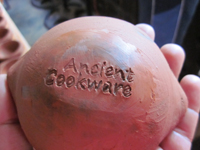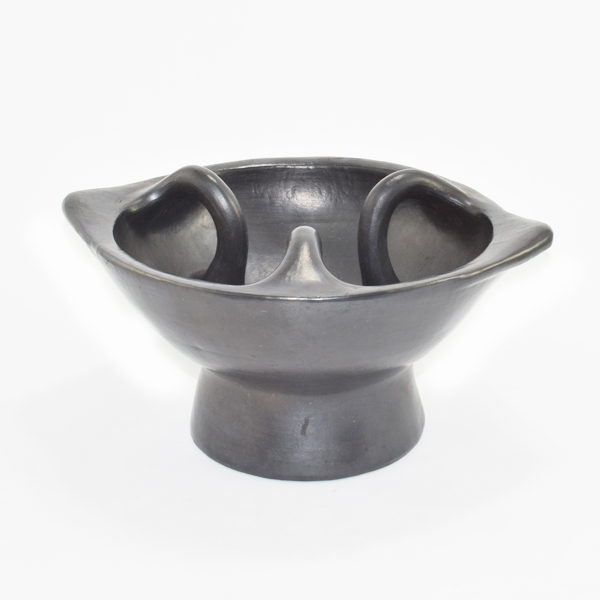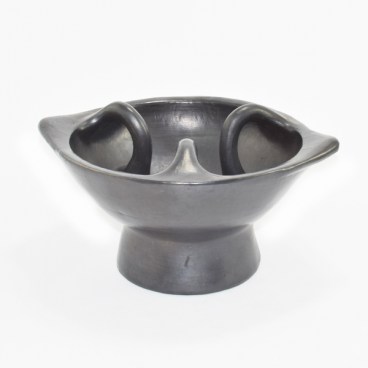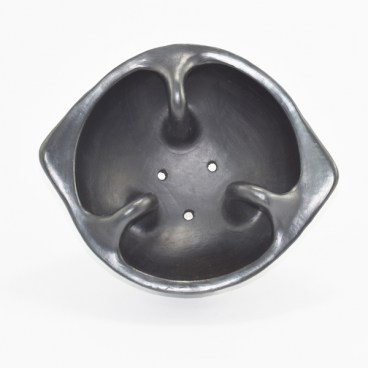Black Clay, La Chamba Brassier
About the piece
Use
Care
How they are Made
If you want to cook or serve this over open fire, no better way than to do it on our Black Clay, La Chamba Brassier. It certainly can make an impressive presentation on any buffet table. The burner fits most Black Clay, La Chamba Pots we sell.
| Item Number: | COL-7167-12 |
| Dimensions (inches): | |
| Length: | 12.0 |
| Width: | 10.0 |
| Height: | 6.0 |
| Diameter: | 10.0 |
| How we measure |  |
About Black Clay, La Chamba, Cookware
Black Clay, La Chamba Cookware, is well-known and used throughout Colombia in restaurants and homes for preparing and serving traditional dishes such as Ajiaco. Its origins can be traced back at least 700 years to vases and pitchers found in pre-Columbian archaeological sites. It is still made in the traditional manner, by families in a small village on the banks of the Magdalena River in Central Colombia.
Appearance
As with most handmade products by artisans around the world, the pieces may have slight imperfections in the form or finish of the materials. Sometimes sizes of same model pieces may also vary slightly, however, these imperfection do not compromise the aesthetics or functionality of the pieces and are considered normal and to be expected. Likewise, although lids are made individually to match each pot, they do not always fit perfectly as the two parts may shrink differently during the firing process.
You may observe with certain use that your pieces may change in color, especially on the bottom where there is direct contact with heat. This is normal and does not affect the pieces in any way.
The Black Clay, La Chamba Brassier is very easy to use and take care of.
In Colombia, the most common way to use the Brassier is to place hot ambers from a fire inside of the Brassier to cook or keep its content warm.
Be careful when using hot coals! It is not recommended to use indoors as the burning ambers (especially charcoal) can be dangerous. When using the Brassier with hot ambers, make sure you are in a well ventilated area; do not use coals in enclosed areas. If outdoors, avoid placing the Brassier where the wind can spread the ashes to flammable materials. Do not put a hot Brassier directly on top of or around any highly-inflammable surfaces. For your safety, use protective mitts when handling the Brassier.
To keep the contents of a pot warm or for service in a buffet table, the most common use is to place canned heat such as Sterno strategically placed inside the Brassier. A 2.6 oz can has the right dimensions for the job (2 1/2" diameter). Of course, candles also work fine, especially if you want to have an authentic and unique presentation, perfect for any occasion.
You should wash and dry the Brassier before first use to remove any dust which could have gathered during shipping.
After using, allow the Brassier to cool before washing as rapid swings in temperature may crack the clay. Simple remove any ash if using ambers and wash the inside before storage. If using candles of canned heat, simply remove the candles or can, and clean out any fuel or wax which was deposited inside the Brassier.
In a small village on the banks of the Magdalena River in central Colombia, live entire families of talented artisans that make Black Clay, La Chamba Pottery. Like their ancestors have done for 700 years. The process of making Black Clay, La Chamba Pottery has remained virtually unchanged since before the Spanish conquest. Still today, there are no mechanical wheels and each piece is made entirely by hand. It is a laborious process of molding, polishing, and firing.
The entire community is dedicated to the production of these ceramics and it is how the community sustains itself. Rather than one artisan completing an entire piece, families or individuals specialize in certain steps of the process, which make the creation of each piece an entire community affair. After each step is completed, the pieces are then transported by burros, motor bikes or even on top of their heads to other families or individuals who complete other steps and so on until the pieces are completely done and packaged.
 Three different types of clays from local mines are used in the making of these ceramics. They are dissolved in water and strained to remove little stones and other impurities. The interior of the ceramics are made with a mixture of a smooth, grey clay that gives the piece its strength and body, and a sandy grey clay that makes it easier to mold. The exterior is then “glazed” with a watery red clay which gives the piece a smooth surface, and allows for the polishing.
Three different types of clays from local mines are used in the making of these ceramics. They are dissolved in water and strained to remove little stones and other impurities. The interior of the ceramics are made with a mixture of a smooth, grey clay that gives the piece its strength and body, and a sandy grey clay that makes it easier to mold. The exterior is then “glazed” with a watery red clay which gives the piece a smooth surface, and allows for the polishing.
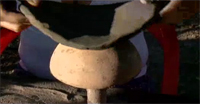 The process begins by flattening a ball of clay and forming it around a mold specifically made for each model. This “shell” is then smoothed and trimmed using tools fashioned from bamboo and plastic pieces.
The process begins by flattening a ball of clay and forming it around a mold specifically made for each model. This “shell” is then smoothed and trimmed using tools fashioned from bamboo and plastic pieces. 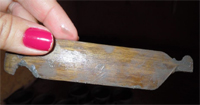 The pieces are then left to air dry, receiving a light polishing during the drying to make sure they have a smooth surface and free of sand. The pieces are then transported to other artisans that specialize in adding rims and/or handles. The handing off progression continues with other artisans which specialize in the production of the lids, which are custom
The pieces are then left to air dry, receiving a light polishing during the drying to make sure they have a smooth surface and free of sand. The pieces are then transported to other artisans that specialize in adding rims and/or handles. The handing off progression continues with other artisans which specialize in the production of the lids, which are custom 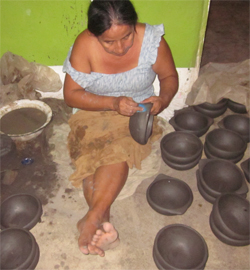 made for each piece. Even the knobs on the lids are made by artisans who specialize in only adding knobs to lids.
made for each piece. Even the knobs on the lids are made by artisans who specialize in only adding knobs to lids.
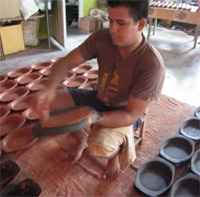 After each step the pieces are laid out to dry in the scorching La Chamba sun. Sometimes the process is delayed due to rains which prevent the drying of the pieces. When it begins to rain, the entire community is mobilized to quickly cover drying pieces that were outside in various production stages. The pieces are then lightly polished with a soft sponge to ensure a smooth exterior, and they are then taken to artisans that glaze each piece with the watery red clay. The glaze is not let to dry completely to allow for the next step of polishing, which is probably the most laborious part of the process, the polishing.
After each step the pieces are laid out to dry in the scorching La Chamba sun. Sometimes the process is delayed due to rains which prevent the drying of the pieces. When it begins to rain, the entire community is mobilized to quickly cover drying pieces that were outside in various production stages. The pieces are then lightly polished with a soft sponge to ensure a smooth exterior, and they are then taken to artisans that glaze each piece with the watery red clay. The glaze is not let to dry completely to allow for the next step of polishing, which is probably the most laborious part of the process, the polishing.
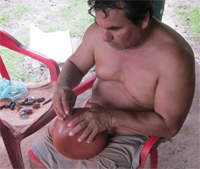 The hand polish, a process known as burnishing, is done by rubbing the entire piece with semiprecious stones until it has a uniform brightness on the surface. Depending on the size of a piece, the polishing can take up to half an hour to an hour. Originally, this polishing was done with smooth river rocks
The hand polish, a process known as burnishing, is done by rubbing the entire piece with semiprecious stones until it has a uniform brightness on the surface. Depending on the size of a piece, the polishing can take up to half an hour to an hour. Originally, this polishing was done with smooth river rocks 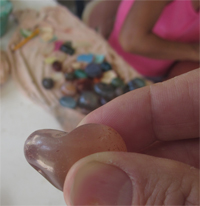 from the bottom of the Magdalena River, but is now done with agate stones brought from Brazil which are stronger. With use, the stones grind down even creating grooves from corners and edges.
from the bottom of the Magdalena River, but is now done with agate stones brought from Brazil which are stronger. With use, the stones grind down even creating grooves from corners and edges.
After the pieces are polished and fully dry, they are taken to be fired in conically shaped, wood burning ovens, although some artisans now use custom made gas kilns which make the process somewhat easier and faster.
 To start the firing process, the pieces are placed inside metal drums, with smaller objects first going inside larger earthenware pieces. These metal drums are then placed in wood burning ovens, usually late in the day so as to minimize the heat to the workers. The firing process takes approximately three hours, with the furnace reaching approximately 750°C. This high heat, together with the glazing and burnishing process, result in utilitarian pieces strong enough to withstand rough treatments and make them ovenproof.
To start the firing process, the pieces are placed inside metal drums, with smaller objects first going inside larger earthenware pieces. These metal drums are then placed in wood burning ovens, usually late in the day so as to minimize the heat to the workers. The firing process takes approximately three hours, with the furnace reaching approximately 750°C. This high heat, together with the glazing and burnishing process, result in utilitarian pieces strong enough to withstand rough treatments and make them ovenproof.
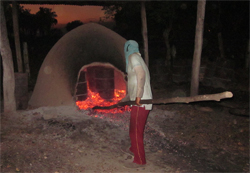 After the firing comes probably the most interesting part of the entire process and is what gives the pieces their unique black color. The metal drums are pulled out of the ovens with the help of long sticks.
After the firing comes probably the most interesting part of the entire process and is what gives the pieces their unique black color. The metal drums are pulled out of the ovens with the help of long sticks.
Processed vegetable materials in the form of saw dust, rice husks, or other materials are then added to the metal drums with the white hot clay pieces still inside. The materials immediately catch fire and begin to smoke. 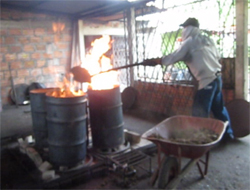 The drums are then covered to extinguish the flames but keep the material smoking vigorously for quite some time. The smoke penetrates the pieces giving each piece the black color that so characterizes products from La Chamba.
The drums are then covered to extinguish the flames but keep the material smoking vigorously for quite some time. The smoke penetrates the pieces giving each piece the black color that so characterizes products from La Chamba.
The entire village and artisans are extremely proud of their products, as we are bringing them to you. 